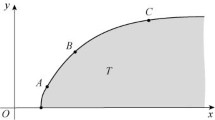Abstract
The use of Data Envelopment Analysis for estimating comparative efficiency has become widespread, and there has been considerable academic attention paid to the development of variants of the basic DEA model. However, one of the principal weaknesses of DEA is that - unlike statistically based methods - it yields no diagnostics to help the user determine whether or not the chosen model is appropriate. In particular, the choice of inputs and out-puts depends solely on the judgement of the user. The purpose of this paper is to examine the implications for efficiency scores of using a misspecified model. A simple production process is set up. Simulation models are then used to explore the effects of applying misspecified DEA models to this process. The phenomena investigated are: the omission of significant variables; the inclusion of irrelevant variables; and the adoption of an inappropriate variable returns to scale assumption. The robustness of the results is investigated in relation to sample size; variations in the number of inputs; correlation between inputs; and variations in the importance of inputs. The paper concludes that the dangers of misspecification are most serious when simple models are used and sample sizes are small. In such circumstances, it is concluded that it will usually be to the modeller's advantage to err on the side of including possibly irrelevant variables rather than run the risk of excluding a potentially important variable from the model.
Similar content being viewed by others
Explore related subjects
Discover the latest articles and news from researchers in related subjects, suggested using machine learning.References
T. Ahn and L.M. Seiford, Sensitivity of DEA to models and variable sets in a hypothesis test setting: The efficiency of university operations, in: Creative and Innovative Approaches to the Science of Management, Y. Ijiri, ed., Quorum Books, Westport, 1993.
A.I. Ali and L.M. Seiford, The mathematical programming approach to efficiency analysis, in: The Measurement of Productive Efficiency, H.O. Fried, C.A.K. Lovell and S.S. Schmidt, eds., Oxford University Press, Oxford, 1993.
R.D. Banker, Econometric estimation and data envelopment analysis, Research in Government and Nonprofit Accounting 5(1989)231–243.
R.D. Banker and R.C. Morey, Efficiency analysis for exogenously fixed inputs and outputs, Operations Research 34(1986)513–521.
R.D. Banker, A. Charnes and W.W. Cooper, Some models for estimating technical and scale efficiencies in Data Envelopment Analysis, Management Science 30(1986)1078–1092.
R.D. Banker, A. Charnes, W.W. Cooper and A. Maindiratta, A comparison of DEA and translog estimates of production frontiers using simulated observations from a known technology in: Applications of Modern Production Theory: Efficiency and Productivity, A. Dogramaci and R. Färe, eds., Kluwer, Boston, 1988.
A. Charnes and W.W. Cooper, Auditing and accounting for program efficiency and management efficiency in not-for-profit entities, Accounting, Organizations and Society 5(1980)87–107.
A. Charnes, W.W. Cooper, D. Divine, T.W. Ruefli and D. Thomas, Comparisons of DEA and existing ratio and regression systems for effecting efficiency evaluations of regulated electric cooperatives in Texas, Research in Government and Nonprofit Accounting 5(1989)187–210.
A. Charnes, W.W. Cooper, A.Y Lewin, R.C. Morey and J. Rousseau, Sensitivity and stability analysis in DEA, Annals of Operations Research 2(1985)139–156.
A. Charnes, W.W. Cooper and E. Rhodes, Measuring the efficiency of decision making units, European Journal of Operational Research 2(1978)429–444.
A. Charnes, W.W. Cooper and E. Rhodes, Short communication: measuring the efficiency of decision making units, European Journal of Operational Research 3(1979)339.
A. Charnes, W.W. Cooper and R.M. Thrall, A structure for classifying and characterizing efficiency and inefficiency in Data Envelopment Analysis, Journal of Productivity Analysis 2(1991)197–237.
J. Doyle and R. Green, Efficiency and cross-efficiency in DEA: Derivations, meanings and uses, Journal of the Operational Research Society 45(1994)567–578.
M.K. Epstein and J.C. Henderson, Data Envelopment Analysis for managerial control and diagnosis, Decision Sciences 20(1989)90–119.
L.G. Godfrey, Misspecification Tests in Econometrics, Cambridge University Press, Cambridge, 1988.
D.F. Hendry, PC-GIVE: An Interactive Econometric Modelling System, Institute of Economics and Statistics, University of Oxford, Oxford, 1989.
T.R. Nunamaker, Using Data Envelopment Analysis to measure the efficiency of non-profit organizations: A critical evaluation, Managerial and Business Economics 6(1985)50–58.
A. Pagan, Three econometric methodologies: A critical appraisal, Journal of Economic Surveys 1(1987)3–24.
L.M. Seiford and R.M. Thrall, Recent developments in DEA, Journal of Econometrics 46(1990) 7–38.
J.K. Sengupta, Data Envelopment Analysis for efficiency measurement in the stochastic case, Computers and Operations Research 14(1987)117–129.
R.M. Thrall, Classification transitions under expansion of inputs and outputs in DEA, Managerial and Decision Economics 10(1989)159–162.
V. Valdmanis, Sensitivity analysis for DEA models. An empirical example using public vs. NFP hospitals, Journal of Public Economics 48(1992)185–205.
Rights and permissions
About this article
Cite this article
Smith, P. Model misspecification in Data Envelopment Analysis. Annals of Operations Research 73, 233–252 (1997). https://doi.org/10.1023/A:1018981212364
Issue Date:
DOI: https://doi.org/10.1023/A:1018981212364




